
Banknotes of the Australian dollar
Encyclopedia
The banknotes of the Australian dollar
were first issued on 14 February 1966, when Australia adopted decimal currency.
requiring larger denominations for transactions. The one dollar note was replaced by a coin
in 1984, while the two dollar note was replaced by a smaller coin in 1988. Although no longer printed, these are still legal tender in Australia, unlike the Australian pound
.
, specifically polypropylene
polymer banknotes (which were produced by Note Printing Australia
), to commemorate the bicentenary of European settlement in Australia. These notes contained a transparent "window" with an optically variable image of Captain James Cook as a security feature. Australian banknotes were the first in the world to use such features. All current Australian banknotes also contain Microprinting
for further security.
There were initial difficulties with the first banknote issued; the $10 note (pictured above) was recalled because of problems with the holographic security feature detaching from the note. However, the Reserve Bank saw potential in the issue of plastic banknotes and commenced preparations for an entirely new series made from polymer
, commencing with the $5 note in 1992. In 1995, the design of the $5 note was updated to match the rest of the New Note Series, with additional slight changes in 1996. In 2001, a special commemorative $5 note was produced, but in 2002, the previous version's production commenced again.
In 2002, the design of all notes (except for the $5 note picturing the Queen) was slightly changed to include the names of the people pictured on them under the portraits, and swapping the order of the signatures of officials on the notes.
Today all Australian notes are made of polymer.
Australian dollar
The Australian dollar is the currency of the Commonwealth of Australia, including Christmas Island, Cocos Islands, and Norfolk Island, as well as the independent Pacific Island states of Kiribati, Nauru and Tuvalu...
were first issued on 14 February 1966, when Australia adopted decimal currency.
Former series (paper)
The $5 note was not issued until 1967. The $1 (10/-,) $2 (£1,) $10 (£5,) and $20 (£10) had exact exchange rates with pounds and were a similar colour to the notes they replaced, but the $5 (£2/10) did not, and so was introduced after the public had become familiar with decimal currency. Notes issued between 1966 and 1973 bore the title "Commonwealth of Australia". Starting from 1974, the title on the new notes only read "Australia" and the legal tender phrase was also changed from “Legal Tender throughout the Commonwealth of Australia and the territories of the Commonwealth” to “This Australian Note is legal tender throughout Australia and its territories.The $50 note was introduced in 1973 and the $100 note in 1984, in response to inflationInflation
In economics, inflation is a rise in the general level of prices of goods and services in an economy over a period of time.When the general price level rises, each unit of currency buys fewer goods and services. Consequently, inflation also reflects an erosion in the purchasing power of money – a...
requiring larger denominations for transactions. The one dollar note was replaced by a coin
Coin
A coin is a piece of hard material that is standardized in weight, is produced in large quantities in order to facilitate trade, and primarily can be used as a legal tender token for commerce in the designated country, region, or territory....
in 1984, while the two dollar note was replaced by a smaller coin in 1988. Although no longer printed, these are still legal tender in Australia, unlike the Australian pound
Australian pound
The pound was the currency of Australia from 1910 until 13 February 1966, when it was replaced by the Australian dollar. It was subdivided into 20 shillings, each of 12 pence.- Earlier Australian currencies :...
.
| Paper Series | |||||||
|---|---|---|---|---|---|---|---|
| Image | Value | Dimensions | Main Colour | Description | Date of issue | ||
| Front | Back | Front | Back | ||||
 |
 |
$1 Australian 1 dollar note The Australian one dollar note was introduced in 1966 to replace the 10 shilling note due to decimalisation. The note was issued from its introduction in 1966 until its replacement by the dollar coin in 1984... |
140 × 70 mm | Brown and orange | Queen Elizabeth II Elizabeth II of the United Kingdom Elizabeth II is the constitutional monarch of 16 sovereign states known as the Commonwealth realms: the United Kingdom, Canada, Australia, New Zealand, Jamaica, Barbados, the Bahamas, Grenada, Papua New Guinea, the Solomon Islands, Tuvalu, Saint Lucia, Saint Vincent and the Grenadines, Belize,... |
David Malangi David Malangi David Malangi was an Indigenous Australian Yolngu artist from the Northern Territory. He was one of the most well known bark painters from Arnhem Land and a significant figure in contemporary Indigenous Australian art. He was born at Mulanga, on the east bank of the Glyde River.He painted on... (artwork) |
1966 |
 |
 |
$2 Australian 2 dollar note The Australian two dollar note was introduced in 1966 to replace the £1 note due to decimalisation.-Security Features:The paper design included a watermark in the white field of Captain James Cook, the watermark was also used in the last issue of pound banknotes. A metallic strip, first near the... |
145 × 71 mm | Green and yellow | John Macarthur John Macarthur (wool pioneer) John Macarthur was a British army officer, entrepreneur, politician, architect and pioneer of settlement in Australia. Macarthur is recognised as the pioneer of the wool industry that was to boom in Australia in the early 19th century and become a trademark of the nation... |
William Farrer William Farrer William James Farrer was a leading Australian agronomist and plant breeder. Farrer is best remembered as the originator of the "Federation" strain of wheat, distributed in 1903... |
1966 |
 |
 |
$5 Australian 5 dollar note The Australian 5 dollar note was first issued in 1967, one year after the currency was changed from the Australian pound to the Australian dollar on 14 February 1966... |
152 × 76 mm | Mauve | Sir Joseph Banks | Caroline Chisholm Caroline Chisholm Caroline Chisholm was a progressive 19th-century English humanitarian known mostly for her involvement with female immigrant welfare in Australia. She is commemorated on 16 May in the Calendar of saints of the Church of England... |
1967 |
 |
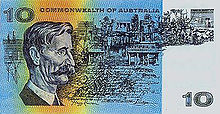 |
$10 | 155 × 76 mm | Blue and orange | Francis Greenway Francis Greenway -References:* *... |
Henry Lawson Henry Lawson Henry Lawson was an Australian writer and poet. Along with his contemporary Banjo Paterson, Lawson is among the best-known Australian poets and fiction writers of the colonial period and is often called Australia's "greatest writer"... |
1966 |
 |
 |
$20 | 160 × 81 mm | Red and yellow | Sir Charles Kingsford Smith | Lawrence Hargrave Lawrence Hargrave Lawrence Hargrave was an engineer, explorer, astronomer, inventor and aeronautical pioneer.- Early life :Hargrave was born in Greenwich, England, the second son of John Fletcher Hargrave and was educated at Queen Elizabeth's Grammar School, Kirkby Lonsdale, Westmorland... |
1966 |
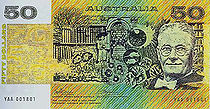 |
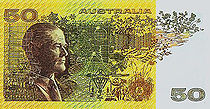 |
$50 | 165 × 82 mm | Gold, blue, brown and green | Baron Florey Howard Walter Florey Howard Walter Florey, Baron Florey OM FRS was an Australian pharmacologist and pathologist who shared the Nobel Prize in Physiology or Medicine in 1945 with Sir Ernst Boris Chain and Sir Alexander Fleming for his role in the making of penicillin. Florey's discoveries are estimated to have saved... |
Sir Ian Clunies Ross Ian Clunies Ross Sir Ian Clunies Ross, CMG is described as the 'architect' of Australia's scientific boom, for his stewardship of Australia's scientific organisation the Commonwealth Scientific and Industrial Research Organisation - CSIRO.-Family:... |
1973 |
 |
 |
$100 | 172 × 82.5 mm | Light blue and grey | Sir Douglas Mawson | John Tebbutt John Tebbutt John Tebbutt was an Australian astronomer, credited with discovering the "Great Comet of 1861" .-Early life:... |
1984 |
Current series (polymer)
In 1988, the Reserve Bank of Australia issued plasticPlastic
A plastic material is any of a wide range of synthetic or semi-synthetic organic solids used in the manufacture of industrial products. Plastics are typically polymers of high molecular mass, and may contain other substances to improve performance and/or reduce production costs...
, specifically polypropylene
Polypropylene
Polypropylene , also known as polypropene, is a thermoplastic polymer used in a wide variety of applications including packaging, textiles , stationery, plastic parts and reusable containers of various types, laboratory equipment, loudspeakers, automotive components, and polymer banknotes...
polymer banknotes (which were produced by Note Printing Australia
Note Printing Australia
Note Printing Australia , which is located in Craigieburn, Melbourne, is a wholly owned subsidiary of the Reserve Bank of Australia and was corporatised in July 1998. NPA has its origins as a subsidiary of the Commonwealth Bank and was established in 1913 to print banknotes for Australia...
), to commemorate the bicentenary of European settlement in Australia. These notes contained a transparent "window" with an optically variable image of Captain James Cook as a security feature. Australian banknotes were the first in the world to use such features. All current Australian banknotes also contain Microprinting
Microprinting
Microprinting is one of many anti-counterfeiting techniques used most often on currency and bank checks, as well as various other items of value. Microprinting involves printing very small text, usually too small to read with the naked eye, onto the note or item. Microprint is frequently hidden in...
for further security.
| First series (1988) http://www.rba.gov.au/banknotes/types/index.html | |
|---|---|
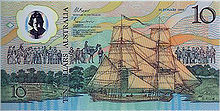 |
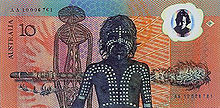 |
There were initial difficulties with the first banknote issued; the $10 note (pictured above) was recalled because of problems with the holographic security feature detaching from the note. However, the Reserve Bank saw potential in the issue of plastic banknotes and commenced preparations for an entirely new series made from polymer
Polymer
A polymer is a large molecule composed of repeating structural units. These subunits are typically connected by covalent chemical bonds...
, commencing with the $5 note in 1992. In 1995, the design of the $5 note was updated to match the rest of the New Note Series, with additional slight changes in 1996. In 2001, a special commemorative $5 note was produced, but in 2002, the previous version's production commenced again.
In 2002, the design of all notes (except for the $5 note picturing the Queen) was slightly changed to include the names of the people pictured on them under the portraits, and swapping the order of the signatures of officials on the notes.
Today all Australian notes are made of polymer.
| Second series (1991- ) http://www.rba.gov.au/banknotes/types/index.html | |||||||||||
|---|---|---|---|---|---|---|---|---|---|---|---|
| Image | Value | Dimensions4 | Weight4 | Main Colour | Description | Date of | |||||
| Front | Back | Front | Back | Transparent Window Image | Embossing5 | printing | issue | ||||
| Original $5 Australian 5 dollar note The Australian 5 dollar note was first issued in 1967, one year after the currency was changed from the Australian pound to the Australian dollar on 14 February 1966... 1 |
130 mm × 65 mm × 0.1130 mm | 0.764 g | Pale mauve | Queen Elizabeth II Elizabeth II of the United Kingdom Elizabeth II is the constitutional monarch of 16 sovereign states known as the Commonwealth realms: the United Kingdom, Canada, Australia, New Zealand, Jamaica, Barbados, the Bahamas, Grenada, Papua New Guinea, the Solomon Islands, Tuvalu, Saint Lucia, Saint Vincent and the Grenadines, Belize,... |
Parliament House Parliament House, Canberra Parliament House is the meeting facility of the Parliament of Australia located in Canberra, the capital of Australia. The building was designed by Mitchell/Giurgola Architects and opened on 1988 by Elizabeth II, Queen of Australia... and old Parliament House |
Gum Eucalyptus Eucalyptus is a diverse genus of flowering trees in the myrtle family, Myrtaceae. Members of the genus dominate the tree flora of Australia... flower |
none | 1992 - 1993 | 7 July 1992 | ||
| Recoloured $5 Australian 5 dollar note The Australian 5 dollar note was first issued in 1967, one year after the currency was changed from the Australian pound to the Australian dollar on 14 February 1966... |
130 mm × 65 mm × 0.1256 mm | 0.783 g | Violet/pink | Currently printing | 24 April 1995 | ||||||
.jpg) |
.jpg) |
Federation $5 Australian 5 dollar note The Australian 5 dollar note was first issued in 1967, one year after the currency was changed from the Australian pound to the Australian dollar on 14 February 1966... 2 |
130 mm × 65 mm × 0.1259 mm | 0.815 g | Sir Henry Parkes | Catherine Helen Spence Catherine Helen Spence Catherine Helen Spence was a Scottish-born Australian author, teacher, journalist, politician and leading suffragette. In 1897 she became Australia's first female political candidate after standing for the Federal Convention held in Adelaide... |
Leaf shaped window | "5" | 2001 | 1 January 2001 | |
| $103 | 137 mm × 65 mm × 0.1294 mm | 0.841 g | Blue | Banjo Paterson Banjo Paterson Andrew Barton "Banjo" Paterson, OBE was an Australian bush poet, journalist and author. He wrote many ballads and poems about Australian life, focusing particularly on the rural and outback areas, including the district around Binalong, New South Wales where he spent much of his childhood... |
Dame Mary Gilmore Mary Gilmore Dame Mary Gilmore DBE was a prominent Australian socialist poet and journalist.-Early life:Mary Jean Cameron was born on 16 August 1865 at Cotta Walla near Goulburn, New South Wales... |
Windmill Windmill A windmill is a machine which converts the energy of wind into rotational energy by means of vanes called sails or blades. Originally windmills were developed for milling grain for food production. In the course of history the windmill was adapted to many other industrial uses. An important... |
Wavy lines | Currently printing | 1 November 1993 | ||
| $20 | 144 mm × 65 mm × 0.1332 mm | 0.900 g | Red | Mary Reibey Mary Reibey Mary Reibey was an Englishwoman who was transported to Australia as a convict but went on to become a successful businesswoman in Sydney.-Early life:... |
Reverend John Flynn John Flynn (minister) John Flynn OBE was an Australian Presbyterian minister who founded the Royal Flying Doctor Service, the world's first air ambulance.-Biography:... |
Compass Compass A compass is a navigational instrument that shows directions in a frame of reference that is stationary relative to the surface of the earth. The frame of reference defines the four cardinal directions – north, south, east, and west. Intermediate directions are also defined... |
"20" | Currently printing | 31 October 1994 | ||
 |
$50 | 151 mm × 65 mm × 0.1400 mm | 0.955 g | Yellow | David Unaipon David Unaipon David Unaipon was an Australian Aboriginal of the Ngarrindjeri people, a preacher, inventor and writer. He was the most widely known Aboriginal in Australia, and broke stereotypes of Aboriginals... |
Edith Cowan Edith Cowan Edith Dircksey Cowan , MBE was an Australian politician, social campaigner and the first woman elected to an Australian parliament.... |
Southern Cross Southern Cross Flag Southern Cross Flags are flags which depict the Southern Cross. "Southern Cross" is the English name of Crux, a constellation visible in the Southern Hemisphere. It is also depicted in coats of arms of various countries and sub-national entities... |
"50" | Currently printing | 4 October 1995 | |
| $100 | 158 mm × 65 mm × 0.1408 mm | 1.006 g | Green | Dame Nellie Melba Nellie Melba Dame Nellie Melba GBE , born Helen "Nellie" Porter Mitchell, was an Australian operatic soprano. She became one of the most famous singers of the late Victorian Era and the early 20th century... |
General Sir John Monash John Monash General Sir John Monash GCMG, KCB, VD was a civil engineer who became the Australian military commander in the First World War. He commanded the 13th Infantry Brigade before the War and then became commander of the 4th Brigade in Egypt shortly after the outbreak of the War with whom he took part... |
Lyrebird Lyrebird A Lyrebird is either of two species of ground-dwelling Australian birds, that form the genus, Menura, and the family Menuridae. They are most notable for their superb ability to mimic natural and artificial sounds from their environment. Lyrebirds have unique plumes of neutral coloured... |
"100" | Currently printing | 15 May 1996 | ||
Remarks
|
|||||||||||
External links
- Australian Decimal Banknotes
- The Money Tracker site allows users to track Australian banknotes as they circulate around Australia.
- The Reserve Bank of Australia have a full timeline of Australian Banknotes.

